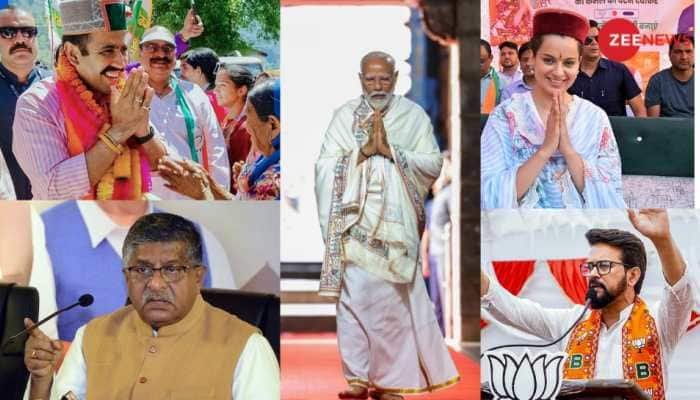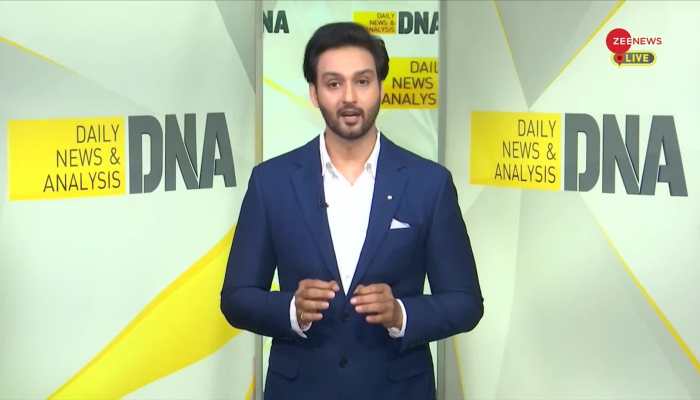Yearender 2018: Major International Political Developments
Here are some of the top events from around the world that created a buzz in the year 2018.
Trending Photos
)
The bygone year 2018 was a year dominated by a handful of influential men whose actions and decisions impacted the fortunes of millions of people around the globe. The year saw leaders making historic peace agreements, global world powers engaging in contentious trade and diplomatic negotiations, the outcome of hard-fought electoral battles raising hopes in some regions and causing concerns in the other.
While Vladimir Putin and Xi Jinping cemented their position in Russia and China respectively, German Chancellor Angela Merkel announced that she would quit in 2021. In Australia, Scott Morrison became the Prime Minister and Brazil saw the rise of right with Jair Bolsanoro being chosen as the President-elect. The MeToo movement, the historic meetings between the two Koreans leaders, the war of words between Trump and Russia over alleged intervention in US Presidential polls, the murder of Saudi dissident Jamal Khashoggi, US pulling out of Iran nuclear deal, Brexit and the killer Tsunami in Indonesia were other big stories which dominated the headlines in 2018.
Here are some of the top events from around the world that created buzz this year:-
Indefinite Powers For China's Xi Jinping

Xi Jinping was re-elected as President by China’s largely rubber-stamp Parliament with 100 percent votes in March. 64-year-old Xi was first elected president for five years in March 2013. Ahead of his re-election as President, the Parliament voted to abolish presidential term limits, effectively allowing him to keep power indefinitely.
Xi, who is regarded as the second most influential Chinese leader after Mao Zedong, was also elected chairman of the state Central Military Commission (CMC). Xi secured all 2,970 ballots cast at meeting of the annual session of the National People’s Congress (NPC) in March.
Together with his re-election as Chinese Communist Party (CCP) general secretary and appointment as chairman of the party CMC, Xi completed his hold on power over party and state. His allies Wang Qishan, 69, and Li Zhanshu, 67, were also elected Vice-President and chairman of the National People's Congress, or Parliament, with 99.9 per cent and 100 per cent of the vote respectively.
The vote was witnessed by journalists inside central Beijing’s Great Hall of the People.
4th term for Vladimir Putin

Suppressing the voice of the Opposition, Vladimir Putin was re-elected President for a second six-year term in March that will see him rule Russia till 2024. His re-election triggered concerns that Putin, who has already been in power for almost two decades, might attempt to modify the country’s constitution to remain in the seat of power.
With nearly 70 percent of the votes, Putin won the 2018 election, which many international observers said was rigged. The Organization for Security and Co-operation in Europe concluded that Russian voters were not given "choice" with "real competition" in the country’s presidential elections and noted that there had been unfair pressure exerted on critical voices.
Continuing his domestic dominance, Putin silenced the sole opposition voice Alexei Navalny and later used the football World Cup in Russia to further consolidate his position. Though Putin emerged a winner in Presidential polls, he faced nationwide protest over changes in state pension rules, his popularity fell amid accusations of high-level corruption in his administration.
Displaying the Russian might abroad, Putin conducted a large military exercise with China, probed NAT’s defences in the Baltic and North Atlantic, allowed KGB to use disinformation campaigns to influence elections in Europe and the Balkans. While the Russian forces seized Ukrainian naval vessels off Crimea, Putin administration continued to back Syrian dictator, Bashar al-Assad, regain control of most of the country.
Donald Trump-Kim Jong Un meet And The Historic Handshake

Several months after making personal attacks and threatening each other with nuclear weapons of mass destruction, US President Donald Trump and North Korean leader Kim Jong Un finally met at a historic summit in Singapore.
This was the first meeting ever between a sitting US President and a North Korean leader. The Trump-Kim meeting came less than two months after the North Korean leader met with South Korean President Moon Jae-in. That summit ended with a declaration that the two Koreas – which have been technically at war for almost 70 years now - will sign a peace treaty.
At the end of Singapore summit, Kim and Trump signed a document in which they agreed “to work toward complete denuclearization of the Korean Peninsula.” In exchange, Trump agreed to "provide security guarantees" to North Korea.
US Pulls Out Of Iran Nuclear Deal

 In a major policy decision in May, US President Donald Trump announced pulling out of the Iran nuclear deal and imposed new sanctions on the Islamic country. Under the 2015 deal, the Joint Comprehensive Plan of Action (JCPOA), involving five permanent members of the United Nations Security Council and Germany, Iran had agreed to stop its nuclear programme in exchange of relief from economic sanctions.
In a major policy decision in May, US President Donald Trump announced pulling out of the Iran nuclear deal and imposed new sanctions on the Islamic country. Under the 2015 deal, the Joint Comprehensive Plan of Action (JCPOA), involving five permanent members of the United Nations Security Council and Germany, Iran had agreed to stop its nuclear programme in exchange of relief from economic sanctions.
Trump said the multilaterally negotiated deal did not sufficiently limit Tehran’s ability to obtain a nuclear weapon or limit its “malign activity” and support for terrorism in the Middle East. He said if Iran continues its nuclear aspirations, “it will have bigger problems than it has ever had before.’’
Trump had termed the Iran nuclear deal a “disaster” during the 2016 campaign and vowed to end it if elected. Trump’s decision to formally end America’s participation in the deal strained Washington’s relations with key allies like France, Germany and the United Kingdom. The move was largely criticized by Washington’s European allies who said that it will aggravate tension and add to instability in West Asia.
Brexit Deal

On November 14, Prime Minister Theresa May and her cabinet approved a negotiated deal with the European leaders laying out the conditions of the UK’s withdrawal from the EU in March 2019.
May's deal came after 19 months of hectic negotiations with the European leaders. It included a Brexit divorce settlement (the Withdrawal Agreement), according to which, Theresa May took a pledge to take back control of laws, borders and money.
The meticulously negotiated deal paid much attention to the preservation of an open border between Northern Ireland and the Republic of Ireland. The UK Parliament was due to vote on Theresa May's controversial Brexit deal on December 11, however, the Prime Minister dramatically abandoned plans at the 11th hour in the wake of huge resistance and fears of "significant" defeat.
This sparked a no-confidence motion against her. Her government was also found in contempt of Parliament for failing to release the advice her government’s lawyers on Brexit. Britain’s exit is due to happen on March 19, 2019, regardless of whether there is a deal with EU or not.
Yellow Vest Protests In France

Tens of thousands of people participated in rallies and protests across France on consecutive Saturdays in a movement which erupted over fuel tax hikes and later snowballed into broader opposition to President Emmanuel Macron.
More than 300 people were wounded nationwide and several died in and outside Paris during several weeks of protests in the European country. More than 400 people were arrested in Paris alone.
The movement originated in May when a woman named Priscillia Ludosky living in the suburbs southeast of Paris and running an internet cosmetics business, launched an internet petition calling for lowering the gas prices. She broke down the price into its components, noting that taxes made up more than half the cost in France.
The petition went mostly unnoticed until October, when Éric Drouet, a truck driver from the same area as Ludosky, ran across it and circulated it among his Facebook friends. Newspapers began writing about the petition, and the number of signatures skyrocketed from an initial 700 to 200,000.
In a bid to end the violent "yellow vest" protests, the French National Assembly approved a package of emergency concessions for low-income workers, which were further put forward by President Emmanuel Macron in a televised address.
The Murder Of Jamal Khashoggi And The Conspiracy Theories

In October, Washington Post columnist and Saudi dissident Jamal Khashoggi walked into the Saudi Consulate in Istanbul only to get some documentation for his wedding. He never came out alive.
In the days that followed, several conspiracy theories emerged seeking to explain what would have possibly happened to Khashoggi.
The Saudis later admitted that he was killed in a brawl by Saudi officials inside the Consulate. The killing sparked global outrage with many critics pointing fingers to the alleged involvement of Crown Prince Mohammad Bin Salman in his killing.
It was alleged that under the leadership of the Saudi Crown Prince, several political dissidents and human rights activists have been repressed in Saudi Arabia. Turkey called for an international inquiry to get a clear picture of the journalist’s last moments. Jamal Khashoggi, a columnist for The Washington Post, was a prominent critic of the Saudi monarchy.
The Trump Administration eventually slapped sanctions on seventeen Saudi nationals for their alleged role in the murder but stopped short of directly implicating the Crown Prince in the killing.
Sri Lanka Political Crisis

The Island nation of Sri Lanka plunged into a deep political crisis after Sri Lankan President Maithripala Sirisena sacked Ranil Wickremesinghe and named Mahinda Rajapakse as Prime Minister in October.
The tussle began after Ranil Wickremesinghe refused to vacate the spot, leaving the country with two claimants to the prime minister’s post and no functioning government.
Wickremesinghe’s dismissal was overturned after fierce opposition from the Sri Lankan court and legislature which called it “illegal.”
Several days later, Sirisena reinstated Wickremesinghe as the prime minister last week, bringing an end to the power struggle in the island nation.
The Killer Tsunami In Indonesia

In Indonesia, more than 1200 people were killed after a 7.5-magnitude earthquake struck the coast of Sulawesi island in September. It triggered waves as high as 20 feet, which surprised the scientists.
However, nature’s fury on Indonesia continued as another Tsunami hit the seismically active Asian island nation on December 23.
Hundreds of people were confirmed dead, more than 1,400 injured and several others went missing along the coastlines of western Java and southern Sumatra islands. The waves that swept locals and tourists into the sea along the Sunda Strait followed an eruption and apparent landslide on Anak Krakatau, or "Child of Krakatoa," one of the world's most infamous volcanic islands.
Hotels and hundreds of homes were heavily damaged by the waves. Broken chunks of concrete and splintered sticks of wood littered hard-hit coastal areas, turning popular beach areas into near ghost towns. Most of the victims were domestic tourists who were visiting beaches during the long weekend ahead of Christmas.
Live Tv







)
)
)
)
)
)
)
)
)
)
